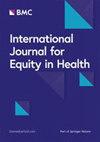沙特阿拉伯王国糖尿病发病率的健康差距和不平等现象
IF 4.5
2区 医学
Q1 PUBLIC, ENVIRONMENTAL & OCCUPATIONAL HEALTH
引用次数: 0
摘要
随着时间的推移,全球卫生系统在医疗保健服务的提供和覆盖方面取得了显著改善。然而,非传染性疾病的日益突出仍然是一个持续的挑战。糖尿病就是这样一种对死亡率和发病率都构成威胁的非传染性慢性疾病。本研究根据统计总局开展的 2018 年沙特家庭健康调查收集的数据,调查了沙特阿拉伯王国糖尿病患病率的社会经济决定因素和不平等现象。分析仅限于在沙特阿拉伯所有 13 个地区选取的 11528 名年龄≥ 18 岁的受访者样本,这些受访者对所有相关变量都做出了完整回答。通过单变量、双变量和多变量逻辑回归分析,探讨了糖尿病患病率的社会经济决定因素。此外,根据浓度曲线的构建和浓度指数的计算,对不平等现象进行了可视化和定量估算。在 11528 名受访者中,糖尿病患病率为 11.20%。年龄、教育程度、收入和居住地区是糖尿病患病率的重要决定因素,年龄越大的受访者患糖尿病的风险越高(几率比 [OR]:与年轻参与者相比,老年参与者患糖尿病的风险更高(几率比 [OR]:12.262,95% 置信区间 [CI]:9.820-15.313,P < 0.01)。不平等分析显示,教育集中指数为负值(-0.235,p < 0.01),表明糖尿病发病率集中在正规教育程度相对较低的人群中。就男性而言,基于收入的集中指数呈显著正值,而基于教育的集中指数呈显著负值,这表明糖尿病更集中于收入较高、教育程度较低的沙特男性。这些发现强调,在制定糖尿病预防和控制的政策和战略时,需要优先考虑社会经济不平等的发病率。重点领域应包括提高所有地区的教育水平、提高对糖尿病的认识以及实施营养干预措施。本文章由计算机程序翻译,如有差异,请以英文原文为准。
Health disparities and inequalities in prevalence of diabetes in the Kingdom of Saudi Arabia
Over time, global health systems have witnessed significant improvements in the delivery and coverage of healthcare services. Nevertheless, the increasing prominence of non-communicable diseases remains a persistent challenge. Diabetes is one such non-communicable chronic disease that poses a threat with respect to both mortality and morbidity. This study investigated the socio-economic determinants and inequalities in the prevalence of diabetes in the Kingdom of Saudi Arabia according to data collected from the 2018 Saudi Family Health Survey conducted by the General Authority for Statistics. The analysis was limited to a sample of 11,528 respondents aged ≥ 18 years, selected across all 13 regions of Saudi Arabia, with complete responses for all variables of interest. Socio-economic determinants in diabetes prevalence were explored with univariate, bivariate, and multivariate logistic regression analyses. Furthermore, inequalities were visualised and quantitatively estimated according to construction of a concentration curve and calculation of the concentration index. The prevalence of diabetes among the 11,528 respondents was 11.20%. Age, education, income, and residence area were significant determinants of diabetes prevalence, with a greater risk of diabetes found in older participants (odds ratio [OR]: 12.262, 95% confidence interval [CI]: 9.820–15.313, p < 0.01) compared to younger participants. Inequality analysis showed a negative education-based concentration index (–0.235, p < 0.01), indicating that diabetes prevalence is concentrated among people with relatively less formal education. For males, the income-based concentration index was significantly positive, whereas the education-based concentration index was significantly negative, indicating a greater concentration of diabetes among Saudi men with higher incomes and less education. These findings emphasize the need to prioritize policies and strategies for diabetes prevention and control with considerations of the socio-economic inequalities in prevalence. Key areas of focus should include improving education levels across all regions, raising awareness about diabetes and implementing nutritional interventions.
求助全文
通过发布文献求助,成功后即可免费获取论文全文。
去求助
来源期刊

International Journal for Equity in Health
Medicine-Health Policy
CiteScore
7.80
自引率
4.20%
发文量
162
审稿时长
28 weeks
期刊介绍:
International Journal for Equity in Health is an Open Access, peer-reviewed, online journal presenting evidence relevant to the search for, and attainment of, equity in health across and within countries. International Journal for Equity in Health aims to improve the understanding of issues that influence the health of populations. This includes the discussion of political, policy-related, economic, social and health services-related influences, particularly with regard to systematic differences in distributions of one or more aspects of health in population groups defined demographically, geographically, or socially.
 求助内容:
求助内容: 应助结果提醒方式:
应助结果提醒方式:


